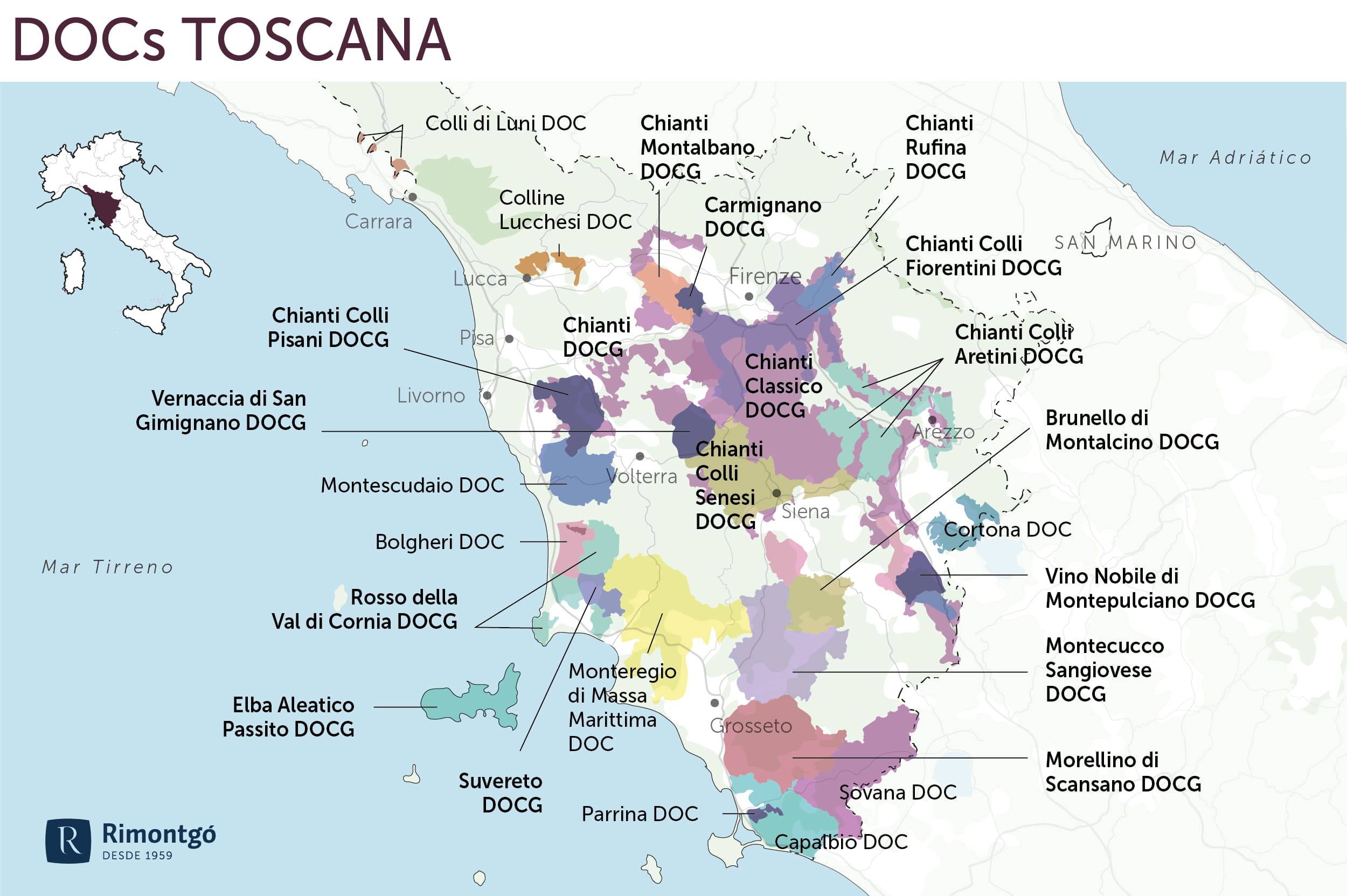Find your winery or vineyard
Infographic of the Denomination of Origin

Change to imperial units (ft2, ac, °F)Change to international units (m2, h, °C)
D.O. year of foundation:
1995
Number of wineries (2017):
74
Total surface area:
1.377 ha3.403 ac
Maximum production allowed:
7.000 kg/ha6.245 lb/ac
Altitude of the vineyards:
Min: 10m
Max: 380m
Min: 33ft
Max: 1.247ft
Temperature:
Min: 12º
Max: 28º
Min: 54°F
Max: 82°F
Yearly hours of sun:
2.273
Yearly rainfall:
600 l/m256 l/ft2
Grosseto
Grosseto is the most populous town in the Maremma in Tuscany.
The history of Grosseto dates back to ancient times, when it was known as “Rusellae”. It was originally founded by the Etruscans, a pre-Roman civilization, around the 7th century BC.
In the 3rd century BC, Rusellae, along with the rest of Etruria, was absorbed into the expanding Roman Republic. Many Roman structures were built in Rusellae, including temples, villas, and aqueducts, leaving lasting architectural remains that can still be seen today.
After the fall of the Western Roman Empire in the 5th century AD, Rusellae was repeatedly sacked by various barbarian tribes, including the Visigoths and the Lombards. During the Early Middle Ages, it became known as “Grosseto” and was part of the Lombard Kingdom.
In the 9th century, Grosseto was incorporated into the Carolingian Empire under Charlemagne, and later fell under the rule of the Holy Roman Empire. In the 13th century, Grosseto was conquered by the Republic of Siena, one of the major city-states of medieval Italy. During this time, many impressive buildings, fortifications and walls were built in Grosseto.
In the mid-16th century, Grosseto, along with the rest of the Republic of Siena, came under the control of the powerful Medici family, who ruled the Grand Duchy of Tuscany.
In the late 18th century, Grosseto went through another change of government as it fell under French control during the Napoleonic era. It became part of the short-lived Kingdom of Etruria, which was established by Napoleon for his brother-in-law, Louis I of Etruria.
In the 19th century, Grosseto, along with the rest of Tuscany, became part of the newly unified Kingdom of Italy, led by King Victor Emmanuel II.
HISTORY OF WINE
The Maremma Hills Wine Route, located in the south-east of the province of Grosseto, includes the municipalities of Capalbio, Orbetello, Isola del Giglio, Magliano in Tuscany, Grosseto, Monte Argentario, Campagnatico, Roccalbegna, Semproniano, Scansano, Manciano, Pitigliano and Sorano. There is much to say, much to narrate, it is one of the largest Routes in Italy, from the sea to the hills to the slopes of the Amiata Mountain.
An ideal itinerary begins on the Island of Giglio, moves to Orbetello, Grosseto and ends in the Argentario.
For lovers of good wine, this is the area of the Ansonica dell'Argentario, a white DOC with a characteristic lively flavour and of the Vermentino di Capalbio, another white DOC.
WINES AND WINERIES
The wines are the main attraction: Ansonica Costa Argentario DOC, Bianco di Pitigliano DOC, Capalbio DOC, Morellino di Scansano DOC and DOCG, Parrina DOC, Sovana DOC, IGT Maremma Toscana White and Red.
The province of Grosseto, located in the southern part of Tuscany, is known for its stunning landscapes, which range from the hills of the Maremma to the coastal areas along the Tyrrhenian Sea. This diverse region has gained increasing recognition for its high-quality wines, driven by both traditional Tuscan varieties and international grapes. Grosseto is home to several DOCs and DOCGs that showcase the uniqueness of its terroir.
One of the most renowned DOCs in Grosseto is the Morellino di Scansano DOCG, which is perhaps the most famous wine of the region. Made primarily from the Sangiovese grape, this red wine is known for its vibrant fruit flavors, smooth tannins, and bright acidity. It is a perfect expression of the Maremma’s coastal climate, offering wines that are both approachable and age-worthy. Morellino di Scansano DOCG has earned a reputation for its quality and is highly regarded both in Italy and internationally.
In addition to Morellino di Scansano, Grosseto also produces wines under the Montecucco DOC designation. This region is known for producing reds made from Sangiovese, as well as whites from Trebbiano and Vermentino. The wines from Montecucco are often characterized by their elegance and balance, with reds offering rich fruit flavors and whites presenting refreshing acidity.
The Grosseto DOC is another important designation in the province, producing wines from a variety of grape varieties, both local and international. The region's winemakers experiment with different styles, producing reds, whites, and rosés that reflect the area’s warm climate and diverse terroir.
The Maremma Toscana DOC encompasses a broad range of wines produced in the Maremma area, including parts of Grosseto. This DOC includes a mix of both indigenous and international varieties, such as Sangiovese, Cabernet Sauvignon, and Merlot, offering wines that range from fresh and fruity to more structured and age-worthy.
Finally, the Toscana IGT designation is used for a variety of wines produced in Grosseto, often featuring a mix of local and international grape varieties. This label provides winemakers with greater freedom to experiment and craft innovative wines that reflect the modern side of Tuscan winemaking.
With its rich viticultural history, diverse terroir, and growing reputation for quality, Grosseto is becoming an increasingly important wine region in Tuscany. The wines from this area, particularly Morellino di Scansano, offer a wonderful expression of the province’s unique landscape, blending tradition with modern innovation.
POINTS OF INTEREST
All the main points of the visit to Grosseto are located within the hexagonal perimeter of almost three km, formed by the six defensive bastions and the wall, one of the bastions being the one that houses the Medici fortress, an imposing Renaissance castle. A walk along the walls allows you to see the city and the Maremma plain. The construction of the walls (1597) is attributed to Francesco I de Medici.
The Duomo of San Lorenzo, a notable landmark, was built in the 13th century. The Benedictine convent of San Francesco also dates back to the 13th century and the Romanesque church of San Pietro is the oldest in Grosseto.
On the coast we find Follónica and Castiglione della Pescaia while inland are the archaeological sites of Roselle and Vetulonia from the Etruscan and Roman periods. Roselle was one of the twelve Etruscan city states, its Etruscan and Roman remains can be found in the walls, the amphitheater, houses, basilica, forum, thermal baths and the temple.
D.O./Valle (wine regions)
Discover more wineries and vineyards for sale in these wine regions in Italy
Subscribe to our mailing list to receive news about wineries and vineyards.







